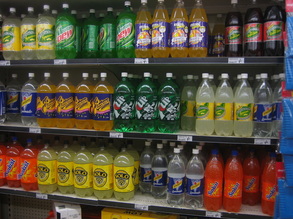 In 2014, Mexicans purchased 137 liters of soda per person – that’s more than 1 liter every 3 days. (Only three countries consume more soda per capita -- Argentina, the United States, and Chile). In 2012, sugary drinks accounted for an astounding 17% of total daily calories consumed among Mexican children and 19% among Mexican adults. Mexico also has the highest overweight and obesity rates in the world, coming in at 72% of its citizens as either overweight or obese, just above the US. In response, Mexico has aggressively implemented policies to address excessive sugary drink consumption and overweight/obesity. In January 2014, Mexican lawmakers implemented a tax of 1 peso (around 7 cents) per liter (about a 10% tax) on any non-dairy, non-alcohol drink with added sugar. Taxes like these are often referred to as “soda taxes” but usually cover more than just soda, as the Mexican tax does. They also passed a companion 8% tax on unhealthy snack food, covering “salty and other snacks, confectionery products, chocolate and products derived from cacao, puddings and flans, candy, peanut butter and hazelnut butter, ice cream, and popsicles.” The preliminary evaluation of the Mexican "soda tax" is in Did the “soda tax” work? Modeling studies have projected that soda taxes, like the one implemented in Mexico, should modestly decrease consumption of sugary drinks, decrease obesity rates, and raise revenue. However, until recently, only limited real-world studies were available to back this up. In June 2015, researchers at the Mexican Institute of Public Health and the Carolina Population Center at the University of North Carolina, Chapel Hill, released preliminary results from their evaluation of the Mexican “soda tax”. They followed a commercial panel of consumers living in 53 cities across Mexico and collected information on their food and drink purchases. After taking into account the pre-tax trends in sugary drink sales, which were declining already, they found a 6% overall drop in sales in 2014, after the tax, compared to the pre-tax period. The effect of the tax was greatest toward the end of 2014 and also was largest among lower-income Mexicans (9% drop in sales, pre- v. post-tax). This sugary drink decline accompanied an increase in water sales. But... There are major caveats with this study. The data are preliminary and have not been published. As with most research, results change once churned through the peer review process. Presently, we don’t know much about the details of the study: exact sources of data, characteristics of participants, the outcome measures, and its limitations. When the study is published, we’ll report back. For now, it appears that the Mexican soda tax is working to both decrease consumption of these drinks and raise revenue. Berkeley, California, recently passed an even larger tax – 1 cent per ounce, or closer to 20%. We’re a long way from knowing the effect of this on sugary drink consumption, but revenue generated in the first month of the tax was an estimated $116,000.
Some argue that a 6% drop in sales won’t translate to a large enough decrease in calories to stem the tide of obesity. In reality, few people hold out soda taxes as the single intervention needed to reverse the epidemic, advocating more of a comprehensive approach that includes taxes. Also, because a tax covers an entire population, every very small changes in calorie intake, on average, should translate to small reductions in obesity. Ultimately, we’ll have to wait until the evaluation of the Mexican study is published and critiqued, and other taxes are evaluated, to know the answer.
0 Comments
Your comment will be posted after it is approved.
Leave a Reply. |
©2017 WeighingInBlog. All rights reserved. 401 Park Drive, Boston, MA




 RSS Feed
RSS Feed

